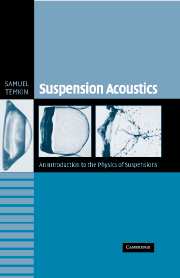Book contents
- Frontmatter
- Contents
- List of Figures and Tables
- Preface
- 1 Preliminaries
- 2 Conservation Equations
- 3 Rigid-Particle Heat Transfer at Re ≪ 1
- 4 Translational Motion at Re ≪ 1
- 5 Shape Deformations
- 6 Volume Pulsations
- 7 Thermodynamics of Suspensions
- 8 The Two-Phase Model
- 9 Sound Propagation in Suspensions
- 10 Applications and Extensions
- Appendix A Material and Transport Properties of Some Substances at 1 atm and 20°C
- Appendix B Useful Formulas from Vector Analysis
- Appendix C Explicit Expressions for Some Quantities in Spherical Polar Coordinates
- Appendix D Some Properties of the Spherical Bessel Functions
- Appendix E Legendre Polynomials
- Bibliography
- Author Index
- Subject Index
- Symbol Index
7 - Thermodynamics of Suspensions
Published online by Cambridge University Press: 25 August 2009
- Frontmatter
- Contents
- List of Figures and Tables
- Preface
- 1 Preliminaries
- 2 Conservation Equations
- 3 Rigid-Particle Heat Transfer at Re ≪ 1
- 4 Translational Motion at Re ≪ 1
- 5 Shape Deformations
- 6 Volume Pulsations
- 7 Thermodynamics of Suspensions
- 8 The Two-Phase Model
- 9 Sound Propagation in Suspensions
- 10 Applications and Extensions
- Appendix A Material and Transport Properties of Some Substances at 1 atm and 20°C
- Appendix B Useful Formulas from Vector Analysis
- Appendix C Explicit Expressions for Some Quantities in Spherical Polar Coordinates
- Appendix D Some Properties of the Spherical Bessel Functions
- Appendix E Legendre Polynomials
- Bibliography
- Author Index
- Subject Index
- Symbol Index
Summary
Introduction
Having examined some of the essential particle motions in fluids, we can begin our study of suspensions. The main interest is the motion of suspensions subject to applied forces. As the last four chapters demonstrate, forces applied to a suspension by the motion of an external wall are transmitted to the particles by the fluid. But, while small particles respond quickly to the fluid, their velocities, pressures, and temperatures will normally lag behind the corresponding quantities in the fluid. Thus, the internal state of a suspension is not one of equilibrium between particles and fluid. This means that it is not generally possible to define such quantities as the temperature or density at a point, as it is in a fluid without particles. One consequence of this is that the physical description of suspensions in motion generally requires methods that differ from those used for homogeneous fluids, where such definitions are possible. Some of those methods will be introduced in the following chapter, with the specific goal of applying them to the study of sound propagation in suspensions.
But, some information may be obtained for suspensions that are either at rest or that are sustaining such slow motions that make it possible to treat them from a thermodynamic point of view. These suspensions are said to be in equilibrium.
- Type
- Chapter
- Information
- Suspension AcousticsAn Introduction to the Physics of Suspensions, pp. 197 - 216Publisher: Cambridge University PressPrint publication year: 2005



